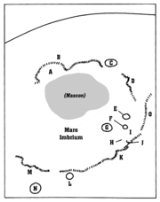
Montes Carpatus
Encyclopedia

Mountain
Image:Himalaya_annotated.jpg|thumb|right|The Himalayan mountain range with Mount Everestrect 58 14 160 49 Chomo Lonzorect 200 28 335 52 Makalurect 378 24 566 45 Mount Everestrect 188 581 920 656 Tibetan Plateaurect 250 406 340 427 Rong River...
range that forms the southern edge of the Mare Imbrium
Mare Imbrium
Mare Imbrium, Latin for "Sea of Showers" or "Sea of Rains", is a vast lunar mare filling a basin on Earth's Moon and one of the larger craters in the Solar System. Mare Imbrium was created when lava flooded the giant crater formed when a very large object hit the Moon long ago...
on the Moon
Moon
The Moon is Earth's only known natural satellite,There are a number of near-Earth asteroids including 3753 Cruithne that are co-orbital with Earth: their orbits bring them close to Earth for periods of time but then alter in the long term . These are quasi-satellites and not true moons. For more...
. The selenographic coordinates of this range are 14.5° N, 24.4° W, and the formation has an overall diameter of 361 km (224.3 mi). They were named after the Carpathian Mountains
Carpathian Mountains
The Carpathian Mountains or Carpathians are a range of mountains forming an arc roughly long across Central and Eastern Europe, making them the second-longest mountain range in Europe...
in Central Europe
Central Europe
Central Europe or alternatively Middle Europe is a region of the European continent lying between the variously defined areas of Eastern and Western Europe...
.
This rugged range generally stretches from west to east. The western end begins in the vicinity of the crater T. Mayer
T. Mayer (crater)
T. Mayer, or Tobias Mayer, is a lunar crater that is located at the western end of the Montes Carpatus mountain range along the southern edge of Mare Imbrium. To the west is the Oceanus Procellarum, and to the south is Mare Insularum...
, although a few low ridges curve northwards towards Euler crater
Euler (crater)
Euler is a lunar impact crater located in the southern half of the Mare Imbrium. The most notable nearby feature is Mons Vinogradov to the west-southwest. There is a cluster of low ridges to the southwest, and this formation includes the small crater Natasha and the tiny Jehan...
. At the eastern extreme is a wide gap where Mare Imbrium in the north joins Mare Insularum
Mare Insularum
Mare Insularum is a lunar mare located in the Insularum basin just south of Mare Imbrium. The basin material is of the Lower Imbrian epoch, with the mare material of the Upper Imbrian epoch. The mare is bordered by the craters Copernicus on the east, and Kepler on the west...
to the south. Starting at the east side of this gap are the Montes Apenninus
Montes Apenninus
Montes Apenninus are a rugged mountain range on the northern part of the Moon's near side. They are named after the Apennine Mountains in Italy....
, another mountainous range that curves up towards the northeast.
Most of this range consists of a series of peaks and rises, separated by valleys that have been penetrated by lava
Lava
Lava refers both to molten rock expelled by a volcano during an eruption and the resulting rock after solidification and cooling. This molten rock is formed in the interior of some planets, including Earth, and some of their satellites. When first erupted from a volcanic vent, lava is a liquid at...
flows. None of the peaks have received individual names, unless one includes Mons Vinogradov
Mons Vinogradov
Mons Vinogradov is a rugged massif that is located on the lunar mare where Oceanus Procellarum to the southwest joins Mare Imbrium to the east. There are three primary peaks in this formation, which rise to altitudes of 1.0–1.4 km above the surface. To the east of this rise is the crater...
to the west of the crater Euler. The surface to the north of the range is nearly level lunar mare
Lunar mare
The lunar maria are large, dark, basaltic plains on Earth's Moon, formed by ancient volcanic eruptions. They were dubbed maria, Latin for "seas", by early astronomers who mistook them for actual seas. They are less reflective than the "highlands" as a result of their iron-rich compositions, and...
, broken only by the occasional wrinkle ridge or minor impact crater.
The region south of the range is somewhat rougher, although still covered by lava flows. About 100 kilometers south of the mountains is the well-known ray crater Copernicus
Copernicus (lunar crater)
Copernicus is a prominent lunar impact crater named after the astronomer Nicolaus Copernicus, located in eastern Oceanus Procellarum. It is estimated to be about 800 million years old, and typifies craters that formed during the Copernican period in that it has a prominent ray system.-...
, and the irregular outer ramparts of this crater stretch almost to the foothills of the Carpatus range. Also of note is the smaller crater Gay-Lussac
Gay-Lussac (crater)
Gay-Lussac is a lunar crater located to the north of the prominent crater Copernicus, in the southern foothills of the Montes Carpatus range. The rim of the crater is slightly distorted, although generally circular. The inner floor is flat but rough, with no central peak. There are a pair of small...
, which is attached to the southern part of the range.

